|
 In
the early morning when shadows are still long people were up and about in Jakiri,
including this man who is sweeping the street. Fortunately the clean-up
discipline pretty much matches the drop-it-where-you-are-ethic or the town would
be heavily trashed. Town clean-up, in most places, is a daily event. In
the early morning when shadows are still long people were up and about in Jakiri,
including this man who is sweeping the street. Fortunately the clean-up
discipline pretty much matches the drop-it-where-you-are-ethic or the town would
be heavily trashed. Town clean-up, in most places, is a daily event.
  The
sun was out and the air was still crisp when we got started. It was cold
if you stood in the shade, but the sun's radiant heat was sufficient to
substitute for a jacket. The
sun was out and the air was still crisp when we got started. It was cold
if you stood in the shade, but the sun's radiant heat was sufficient to
substitute for a jacket.
 Higher on the hills the small farms were mostly agriculturally oriented.
As we descended, this section of the Nun Valley seemed dryer and less fertile
than areas further to the west.
Higher on the hills the small farms were mostly agriculturally oriented.
As we descended, this section of the Nun Valley seemed dryer and less fertile
than areas further to the west.




Here are four picture (below) from the same area in 1986:




 In the more arid areas, if current practice is any indication, the best use of
the resources seemed to be grazing cattle, though there were large areas that
seemed to be totally unexploited grasslands.
In the more arid areas, if current practice is any indication, the best use of
the resources seemed to be grazing cattle, though there were large areas that
seemed to be totally unexploited grasslands.

 In one section we passed a couple of
groups carrying bundles of stick on their heads. It looked like it was no
short trip. If they are traveling long distances to collect fire wood it
doesn't bode well for what remains of trees in the area. In one section we passed a couple of
groups carrying bundles of stick on their heads. It looked like it was no
short trip. If they are traveling long distances to collect fire wood it
doesn't bode well for what remains of trees in the area.


 Continuing further east the land gets a little hillier and wetter. In one
community they had built some fish ponds. This is sort of "fish by
numbers" project. At the beginning the fish farmer know the size of the
pond. With that information he know how many fry's (frequently Nile
tilapia) he needs to start with. With the pond full of water the fry's are
release and you feed the pond is fed to keep a good algae bloom. After an
appropriate number of month for the specie of fish being used -- maybe six
months -- the pond is drained and everything is harvested and prepared for
market, except the number of fry's needed to restock the pond, which are set
aside. The pond is refilled, the fry's that were set aside are released
and the cycle is repeated.
Continuing further east the land gets a little hillier and wetter. In one
community they had built some fish ponds. This is sort of "fish by
numbers" project. At the beginning the fish farmer know the size of the
pond. With that information he know how many fry's (frequently Nile
tilapia) he needs to start with. With the pond full of water the fry's are
release and you feed the pond is fed to keep a good algae bloom. After an
appropriate number of month for the specie of fish being used -- maybe six
months -- the pond is drained and everything is harvested and prepared for
market, except the number of fry's needed to restock the pond, which are set
aside. The pond is refilled, the fry's that were set aside are released
and the cycle is repeated.
Another agricultural product that needs more water is coffee. There are
basically two ways to prepare the unroasted 'green beans' that are traded on the
world market.
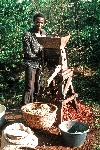 The
big producers take the ripe, red pods and crack the shell open in automated
machines that separates the shell from the beans. The beans then go into
large tanks or vats of water where they are fermented (about three days.) It is
then dried and becomes the 'green bean' ready for the global market. In
Cameroon, much of the coffee is grown by small producers. Smaller
producers, like the gentleman in the picture, ferment the grain in the shell
(7-10 days), then crack the shell and dry the 'green bean' until it is ready to
sell to the coffee market organization. Unfortunately, even though this
process is more labor intensive, the small producers tend to get a lower price
for their beans. The
big producers take the ripe, red pods and crack the shell open in automated
machines that separates the shell from the beans. The beans then go into
large tanks or vats of water where they are fermented (about three days.) It is
then dried and becomes the 'green bean' ready for the global market. In
Cameroon, much of the coffee is grown by small producers. Smaller
producers, like the gentleman in the picture, ferment the grain in the shell
(7-10 days), then crack the shell and dry the 'green bean' until it is ready to
sell to the coffee market organization. Unfortunately, even though this
process is more labor intensive, the small producers tend to get a lower price
for their beans.
 Approaching from the west the first prominent building you see in Foumban are
churches. There is a little irony in this because Foumban is a more
Islamic area.
Approaching from the west the first prominent building you see in Foumban are
churches. There is a little irony in this because Foumban is a more
Islamic area.
 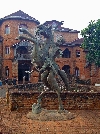 One
of the impressive buildings in Foumban is the Sultan of Bamoun's palace.
The Sultans changed their title from fon when the converted to Islam around the
beginning of the 20th centrury. There
is a statue of what appears to be an Islamic warrior in the front of the palace. One
of the impressive buildings in Foumban is the Sultan of Bamoun's palace.
The Sultans changed their title from fon when the converted to Islam around the
beginning of the 20th centrury. There
is a statue of what appears to be an Islamic warrior in the front of the palace.
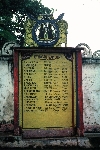 On the palace wall there is a list of all of the Bamoun Dynasty Fons/Sultans up
to the 18th, Njoya Seydou, who was enthroned in 1933. To bring this up to
date, Sultan Njoya Seydou died in 1992 and Ibrahim Mbombo Njoya was enthroned as
the 19th Sultan of Bamoun. On the palace wall there is a list of all of the Bamoun Dynasty Fons/Sultans up
to the 18th, Njoya Seydou, who was enthroned in 1933. To bring this up to
date, Sultan Njoya Seydou died in 1992 and Ibrahim Mbombo Njoya was enthroned as
the 19th Sultan of Bamoun.
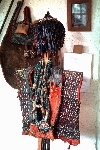 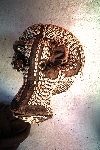 The
second floor of the palace houses a museum of royal items of the Bamoun Kingdom,
including the symbols of power, personal items from the Fons, books, musical instruments, masks, weapons, etc. The
second floor of the palace houses a museum of royal items of the Bamoun Kingdom,
including the symbols of power, personal items from the Fons, books, musical instruments, masks, weapons, etc.



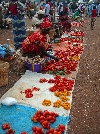 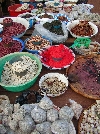 Outside
the palace is the art/craft market and the general market. For a business
that depends upon tourism the merchants in the artisans market have distinctly
antagonistic marketing strategies. It is of their own making that there
are no photographs of them. Whether
it is their intention or
not, they come across as ornery and to the extent that I have had the stamina to
engage them, their prices are high. On the other hand it is interesting,
engaging and colorful to wander in the general market. Outside
the palace is the art/craft market and the general market. For a business
that depends upon tourism the merchants in the artisans market have distinctly
antagonistic marketing strategies. It is of their own making that there
are no photographs of them. Whether
it is their intention or
not, they come across as ornery and to the extent that I have had the stamina to
engage them, their prices are high. On the other hand it is interesting,
engaging and colorful to wander in the general market.
 Linguistics notes for the day: The area around Jikiri and Kumbo is
linguistically fairly homogeneous with Lamnso' (Ring>East) as the primary
languages. As you drop down into the Nun Valley we reentered the
Mbam-Nkam>Nun language group, for which Bamoun, the language of Foumban, is
one of the largest. There is probably an (or some) other language(s) spoken
between Jakiri and Foumban, like Bangolan, but we didn't talk to anyone with
specific
information to this effect. Linguistics notes for the day: The area around Jikiri and Kumbo is
linguistically fairly homogeneous with Lamnso' (Ring>East) as the primary
languages. As you drop down into the Nun Valley we reentered the
Mbam-Nkam>Nun language group, for which Bamoun, the language of Foumban, is
one of the largest. There is probably an (or some) other language(s) spoken
between Jakiri and Foumban, like Bangolan, but we didn't talk to anyone with
specific
information to this effect.
|































 Please
contact us
Please
contact us